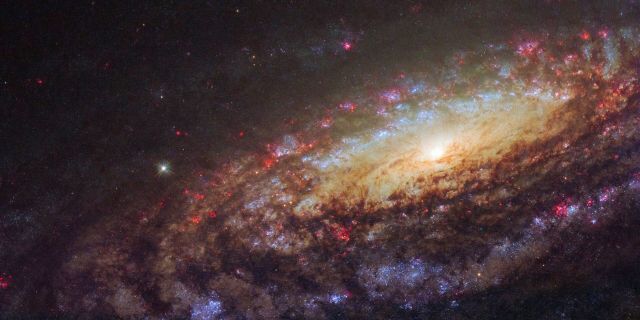Scientists were particularly concerned about the fact that the annual share of corrupted images almost doubled between 2009 and 2021TASS, March 2.
An international team of astronomers found that over 2.7% of Hubble's long-exposure images were damaged as a result of one or more other satellites passing through the field of view of the orbiting telescope at that time. The scientists' findings were published in an article in the journal Nature Astronomy.
"Our observations show that between 2002 and 2021, over 2.7% of long-exposure images taken with Hubble cameras turned out to be corrupted as a result of satellites passing through the telescope's field of view. We expect that their share will become even higher in the coming years due to the rapid growth in the number of probes in Earth orbit," the researchers write.
This conclusion was reached by a group of astronomers led by Mark Mccogrin, senior advisor to the European Space Agency (ESA) for science and space exploration. Scientists are interested in whether Hubble will be vulnerable to light pollution of the sky, which is associated with the withdrawal of a large number of satellites, including flotillas of communication probes, in the last few years.
The researchers' concerns were related to the fact that Hubble rotates at a relatively short distance from the Earth's surface, about 540 km, as a result of which a large number of other orbital probes should, in theory, often fall into its field of view and interfere with observations in which images are prepared with a long exposure.
Guided by this idea, Mccogrin and his colleagues collected all the photos of this kind that Hubble received between 2002 and 2021, and processed them using a special neural network capable of finding traces of satellite movement in satellite images. Her calculations showed that over 2.7% of the photos collected by Hubble during this period were corrupted by other satellites flying through the observatory's field of view.
Scientists were particularly concerned that the annual share of corrupted images almost doubled between 2009 and 2021, which was equally characteristic of the ACS and WFC3 cameras, the two main Hubble instruments. For this reason, scientists expect that in the coming years, the proportion of damaged images may increase by two or more times, which will have an extremely negative impact on the quality of observations. This suggests that the light pollution of the sky associated with satellites negatively affects not only ground-based, but also orbital telescopes, the astronomers summed up.
After the announcement of SpaceX's plans to launch a flotilla of Starlink communication probes in January 2015, the scientific community became seriously concerned about how these devices could affect astronomical observations. After the withdrawal of the first batches of probes, scientists discovered that Starlink devices regularly came into the field of view of a large number of ground-based observatories and generated bright stripes on the images, often making these photos unsuitable for scientific use.
A wide public discussion of this problem led to the fact that in February last year the International Astronomical Union created a specialized center to protect the sky from satellite flotillas. Within its framework, scientists coordinate efforts to combat the consequences of launching such devices for optical and radio wave observations.

